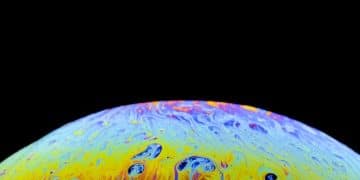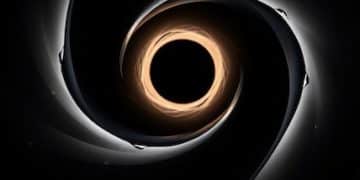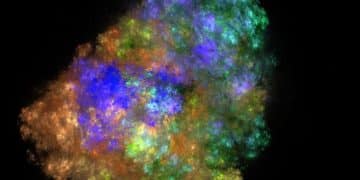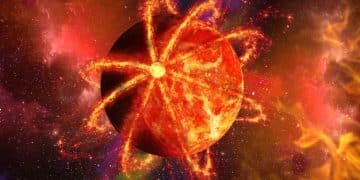Dark Energy Explained: Unveiling the Universe’s Expansion Theories
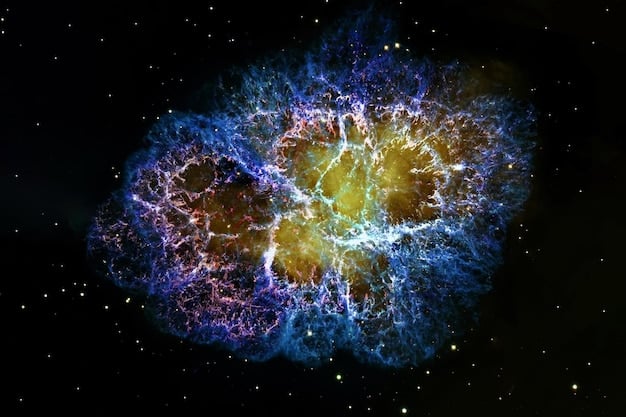
Dark energy, a mysterious force, is believed to be responsible for the accelerating expansion of the universe, and several theories, including the cosmological constant and quintessence, attempt to explain its nature and behavior.
The universe is expanding, and not just at a steady rate. It’s accelerating. Scientists attribute this acceleration to a mysterious force called dark energy. But what is it? What are the leading theories attempting to explain this cosmic phenomenon?
Understanding the Enigma of Dark Energy
Dark energy is one of the biggest mysteries in modern cosmology. It makes up approximately 68% of the universe’s total energy content, yet we know very little about it. Understanding dark energy is crucial to understanding the fate of the universe.
Its discovery came from observations of distant supernovae, which appeared fainter than expected. This implied that the universe’s expansion was accelerating, rather than slowing down as previously thought.

The Cosmological Constant: Einstein’s Legacy
One of the primary contenders to describe dark energy is the cosmological constant. This concept, initially introduced by Albert Einstein in his theory of general relativity, represents a constant energy density that permeates all of space.
Einstein originally introduced the cosmological constant to create a static universe, but later abandoned it when the universe was found to be expanding. However, it has since been revived as a possible explanation for dark energy.
What is the Cosmological Constant?
The cosmological constant, denoted by the Greek letter lambda (Λ), is essentially a constant energy density that exists uniformly throughout space. It can be thought of as the energy of empty space itself.
The Quantum Vacuum Connection
One interpretation of the cosmological constant links it to the concept of the quantum vacuum. Quantum field theory suggests that even empty space is not truly empty but is filled with virtual particles that pop in and out of existence.
- The cosmological constant offers a simple and elegant explanation for dark energy.
- It aligns with Einstein’s theory of general relativity.
- It predicts a constant energy density throughout the universe.
Though the cosmological constant fits well within our current understanding of physics, it also presents a significant problem: the predicted value from quantum field theory is vastly larger (by a factor of 10120) than the observed value, known as the “cosmological constant problem.”
Quintessence: A Dynamic Dark Energy
Another compelling theory to explain dark energy is quintessence. Unlike the cosmological constant, which postulates a constant energy density, quintessence suggests that dark energy is dynamic and changes over time.
Quintessence is a hypothetical form of dark energy proposed as an alternative to the cosmological constant. It is described by a scalar field, similar to the fields that describe fundamental forces in physics.

Scalar Fields and Dark Energy
At the heart of quintessence is the idea of a scalar field. Scalar fields are fields that have a value at every point in space, and their energy density can change over time depending on the dynamics of the field.
Tracking Behavior and Evolution
Quintessence models often incorporate “tracking behavior,” where the energy density of the quintessence field evolves to closely follow the dominant energy component of the universe, such as matter or radiation, before eventually dominating the expansion.
- Quintessence allows for a time-varying equation of state parameter.
- It offers a potential solution to the cosmological constant problem.
- It introduces new dynamics and complexities to the study of dark energy.
While quintessence offers a more flexible framework for understanding dark energy’s behavior, it also requires the introduction of new particles and fields, which have not yet been directly observed. Moreover, models of quintessence must be carefully tuned to match the observed expansion history.
Modified Gravity: Altering Our Understanding of Gravity
A third approach to explaining the accelerating expansion involves modifying our understanding of gravity itself. Instead of invoking dark energy, these theories propose alterations to Einstein’s theory of general relativity on cosmic scales.
Modified gravity theories suggest that the observed acceleration is not due to a new form of energy but rather to the fact that general relativity may no longer be accurate on the largest scales.
f(R) Gravity
One of the most well-studied modified gravity theories is f(R) gravity, where the Einstein-Hilbert action, which describes general relativity, is modified by replacing the Ricci scalar R with a more general function f(R).
Testing Modified Gravity Theories
Testing modified gravity theories is challenging because they must not only explain the late-time acceleration but also match the precise predictions of general relativity on smaller scales, such as within the solar system.
- Modified gravity offers an alternative to dark energy.
- It challenges our fundamental understanding of gravity.
- It requires rigorous testing on various scales.
Modified gravity theories provide an intriguing possibility for explaining the accelerating expansion without invoking new forms of energy. However, they often face challenges in reconciling their predictions with observations on different scales and can introduce new complexities into the equations governing the universe.
The Holographic Dark Energy Model
The holographic dark energy model is based on the holographic principle from quantum gravity, which suggests that the information contained within a volume of space can be represented on the boundary of that space.
This model draws a connection between the energy density of dark energy and the size of the observable universe, suggesting that dark energy is related to the holographic information content of the universe.
Holographic Principle in Cosmology
The holographic principle, originally developed in the context of black holes, posits that the maximum amount of information that can be contained within a volume is proportional to the area of its boundary, rather than its volume.
Implications for Dark Energy
In the holographic dark energy model, the energy density of dark energy is related to the Hubble parameter and the size of the event horizon of the universe. This relationship ensures that the dark energy density is consistent with the holographic principle.
- Connects dark energy to fundamental principles of quantum gravity.
- Provides a different perspective on the nature of dark energy.
- Offers potential insights into the relationship between gravity and quantum mechanics.
The holographic dark energy model offers a unique perspective on the nature of dark energy, suggesting that it is fundamentally linked to the quantum properties of spacetime. However, it also raises questions about the underlying physics and the interpretation of the holographic principle in the context of cosmology.
Challenges and Future Directions
Despite the progress that has been made in understanding dark energy, many questions remain unanswered. The cosmological constant problem, the nature of quintessence, and the viability of modified gravity theories continue to be major challenges.
Future observations, such as those from the Dark Energy Spectroscopic Instrument (DESI) and the Euclid space telescope, will play a crucial role in refining our understanding of dark energy and testing the various theories that have been proposed.
New Observational Probes
Future surveys will provide more precise measurements of the expansion history of the universe, the growth of structure, and the properties of dark energy. These observations will help us to distinguish between different models and constrain their parameters.
Refining Theoretical Models
In parallel with new observations, theoretical physicists are working to refine our understanding of dark energy and develop new models that can address the challenges and inconsistencies of existing theories.
- The cosmological constant problem remains a major challenge.
- Future observations will play a crucial role in testing dark energy theories.
- Theoretical models need to be refined to address remaining inconsistencies.
The quest to understand dark energy and the accelerating expansion of the universe is one of the most exciting and challenging frontiers in modern cosmology. It requires a combination of cutting-edge observations and innovative theoretical ideas to unravel the mysteries of the cosmos.
| Key Concept | Brief Description |
|---|---|
| 🌌 Cosmological Constant | Einstein’s concept of constant energy density filling space. |
| 🌠 Quintessence | Dynamic dark energy described by scalar fields, changing over time. |
| ✨ Modified Gravity | Alters general relativity to explain expansion without dark energy. |
| 🔮 Holographic Model | Dark energy linked to the holographic information content of the universe. |
Frequently Asked Questions
▼
Dark energy is a mysterious force that makes up about 68% of the universe. It’s responsible for the accelerating expansion of the universe, but its nature remains poorly understood.
▼
Dark energy was discovered through the observation of distant supernovae. These supernovae appeared fainter than expected, indicating that the universe was expanding at an accelerating rate.
▼
No, dark energy and dark matter are different. Dark matter is a form of matter that interacts gravitationally but doesn’t interact with light. Dark energy is a force causing accelerated expansion.
▼
Leading theories include the cosmological constant, quintessence, and modified gravity. The cosmological constant is a constant energy density, while quintessence is a dynamic energy field.
▼
Future observations, such as those from DESI and Euclid, will provide more precise measurements of the universe’s expansion history. This data will help refine our understanding of dark energy.
Conclusion
Unraveling the mystery of dark energy remains one of the most significant challenges in modern cosmology. While various theories attempt to explain its nature and behavior, ongoing and future research will undoubtedly shed more light on this enigmatic force driving the universe’s accelerating expansion.
